Accept all cookies Accept only essential cookies See our Cookie Notice

About ESA
The European Space Agency (ESA) is Europe’s gateway to space. Its mission is to shape the development of Europe’s space capability and ensure that investment in space continues to deliver benefits to the citizens of Europe and the world.
Highlights
ESA - United space in Europe
This is ESA ESA facts Member States & Cooperating States Funding Director General Top management For Member State Delegations European vision European Space Policy ESA & EU Space Councils Responsibility & Sustainability Annual Report Calendar of meetings Corporate newsEstablishments & sites
ESA Headquarters ESA ESTEC ESA ESOC ESA ESRIN ESA EAC ESA ESAC Europe's Spaceport ESA ESEC ESA ECSAT Brussels Office Washington OfficeWorking with ESA
Business with ESA ESA Commercialisation Gateway Law at ESA Careers Cyber resilience at ESA IT at ESA Newsroom Partnerships Merchandising Licence Education Open Space Innovation Platform Integrity and Reporting Administrative Tribunal Health and SafetyMore about ESA
History ESA Historical Archives Exhibitions Publications Art & Culture ESA Merchandise Kids Diversity ESA Brand Centre ESA ChampionsLatest
Space in Member States
Find out more about space activities in our 23 Member States, and understand how ESA works together with their national agencies, institutions and organisations.
Science & Exploration
Exploring our Solar System and unlocking the secrets of the Universe
Go to topicAstronauts
Missions
Juice Euclid Webb Solar Orbiter BepiColombo Gaia ExoMars Cheops Exoplanet missions More missionsActivities
International Space Station Orion service module Gateway Concordia Caves & Pangaea BenefitsLatest
Space Safety
Protecting life and infrastructure on Earth and in orbit
Go to topicAsteroids
Asteroids and Planetary Defence Asteroid danger explained Flyeye telescope: asteroid detection Hera mission: asteroid deflection Near-Earth Object Coordination CentreSpace junk
About space debris Space debris by the numbers Space Environment Report In space refuelling, refurbishing and removingSafety from space
Clean Space ecodesign Zero Debris Technologies Space for Earth Supporting Sustainable DevelopmentLatest
Applications
Using space to benefit citizens and meet future challenges on Earth
Go to topicObserving the Earth
Observing the Earth Future EO Copernicus Meteorology Space for our climate Satellite missionsCommercialisation
ESA Commercialisation Gateway Open Space Innovation Platform Business Incubation ESA Space SolutionsLatest
Enabling & Support
Making space accessible and developing the technologies for the future
Go to topicBuilding missions
Space Engineering and Technology Test centre Laboratories Concurrent Design Facility Preparing for the future Shaping the Future Discovery and Preparation Advanced Concepts TeamSpace transportation
Space Transportation Ariane Vega Space Rider Future space transportation Boost! Europe's Spaceport Launches from Europe's Spaceport from 2012Latest
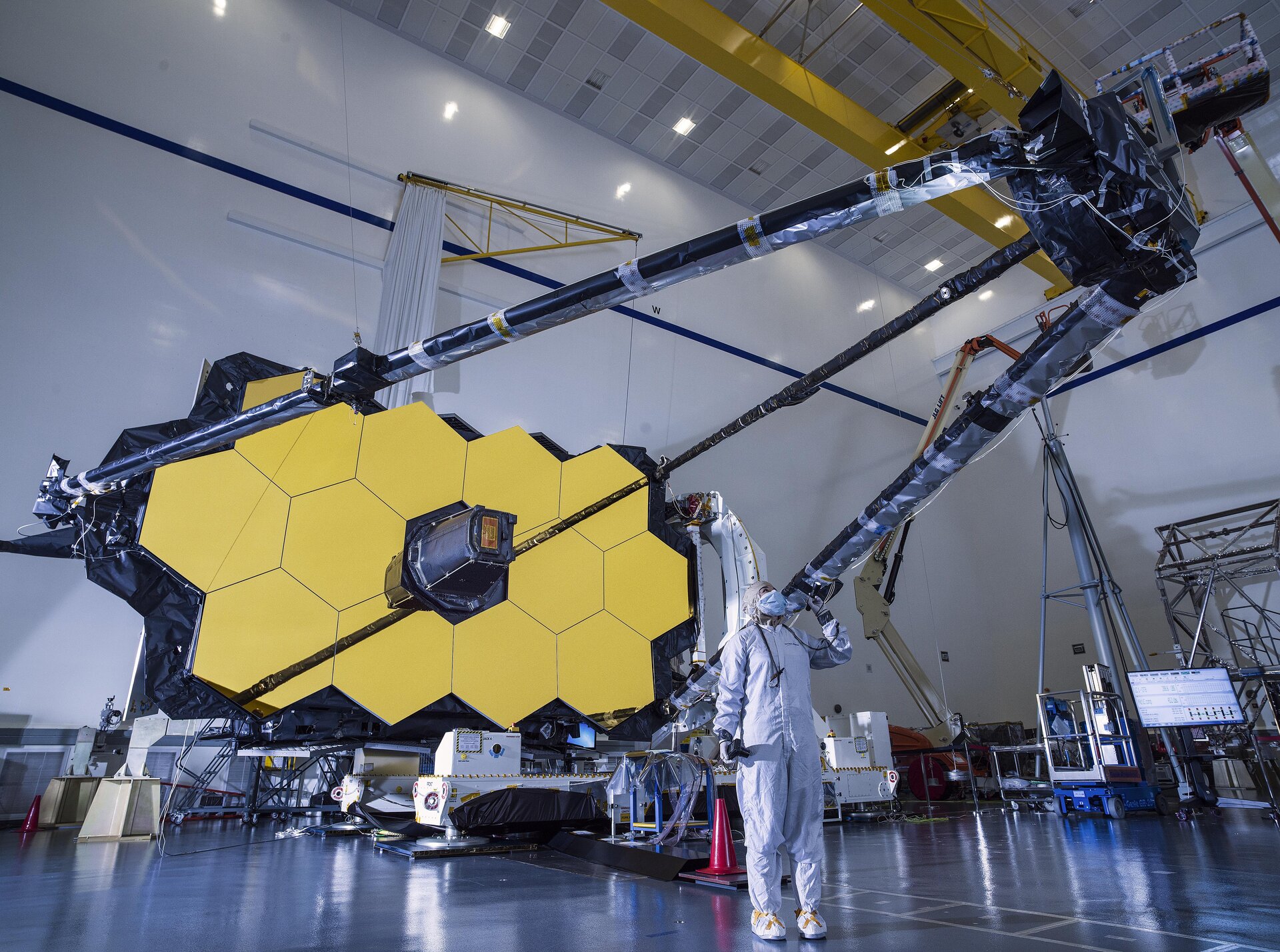
Deployment test of Webb’s secondary mirror
Thank you for liking
You have already liked this page, you can only like it once!
The secondary mirror – visible in the top right corner of the image – is among the most important pieces of equipment on the NASA/ESA/CSA James Webb Space Telescope (JWST) and is essential to the success of the mission.
Folded together with the other observatory components during launch, the secondary mirror will be deployed as part of an intricate choreography that will bring the observatory to life once in space. When deployed, like in this view, it faces Webb’s iconic honeycomb-like pattern of 18 hexagonal, gold-coated primary mirror segments. This primary mirror structure is seen in the lower left of the image in its folded configuration, showing only 12 segments.
Once the observatory is in space, light from distant stars and galaxies will first reach its primary mirror, which reflect it into a focused beam towards the secondary mirror. From there, the beam is then sent through the ‘hole’ in the primary mirror structure into the tertiary and fine steering mirrors, and eventually to the four scientific instruments, which sit behind the primary mirror in this view.
Technicians and engineers recently tested a key part of the telescope unfolding choreography by successfully commanding Webb to deploy the support structure that holds its secondary mirror in place. This is a critical milestone in preparing the observatory for its journey to orbit, as the proper deployment and positioning of the telescope’s secondary mirror is critical to perform the mission’s revolutionary science.
This successful test also provided another demonstration that the electronic connection between the spacecraft and the telescope is working properly, and is capable of delivering commands throughout the observatory as designed.
Next on the list of key mission milestones is the integration of the James Webb Space Telescope’s two halves – the telescope element, which comprises the mirrors and science instruments, and the spacecraft and sunshield element – into its final form as a complete observatory.
Currently at Northrop Grumman Aerospace Systems in Redondo Beach, California, Webb is scheduled for launch on a European Ariane 5 rocket from French Guiana in March 2021.
The James Webb Space Telescope is an international project led by NASA with its partners, ESA and the Canadian Space Agency. As part of its contribution to the project, ESA provides the NIRSpec instrument, the Optical Bench Assembly of the MIRI instrument, the Ariane 5 launcher, and staff to support mission operations at the Space Telescope Science Institute (STScI) in Baltimore, USA.
-
CREDIT
NASA/C. Gunn -
LICENCE
ESA Standard Licence
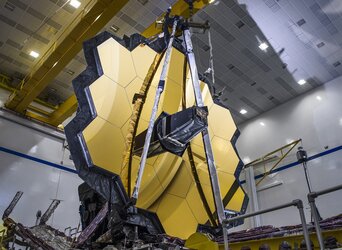
James Webb Space Telescope's primary mirror unfolded
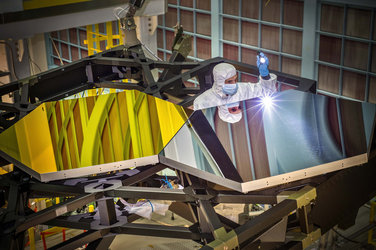
Test mirror segments for the James Webb Space Telescope
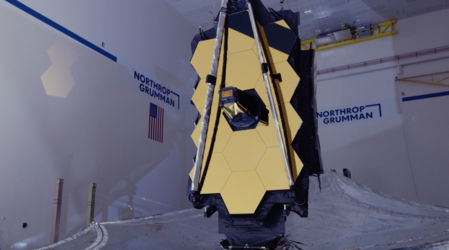
Webb mirror beauty
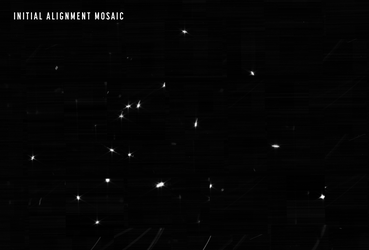
Webb sees its first star - 18 times
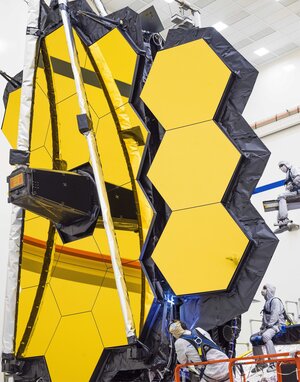














 Germany
Germany
 Austria
Austria
 Belgium
Belgium
 Denmark
Denmark
 Spain
Spain
 Estonia
Estonia
 Finland
Finland
 France
France
 Greece
Greece
 Hungary
Hungary
 Ireland
Ireland
 Italy
Italy
 Luxembourg
Luxembourg
 Norway
Norway
 The Netherlands
The Netherlands
 Poland
Poland
 Portugal
Portugal
 Czechia
Czechia
 Romania
Romania
 United Kingdom
United Kingdom
 Slovenia
Slovenia
 Sweden
Sweden
 Switzerland
Switzerland

























